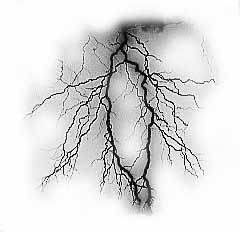

Invisible Magnetospheric Propogation
So, what does this have to do with being an artist and teacher? Earth-stuff is the source of my work.
Recently, I discovered through my friend Steven McGreevy the wonderful sounds coming from lightning that can only be heard with special radio receivers operating in the audio part of the spectrum, but unheard by the human ear. It seems that lightning storms on the far side of the planet cause very low frequency waves, invisably propogated by the Magnetosphere. The Aurora does a similar thing too and it is his dream to videotape the Aurora and add these normally unheard sounds. I now have one of his receivers and listen for these strange sounds.
What this research proves to me is that natural phenomena here on our home planet are rich in multimedia events. My goal is to create personal responses to some of these events using my experience in sculpture, sound and photography. Continual research shows me new processes and tools by which I can learn more and express what it is I find intriguing and hopefully universal for others. I admit to also being fascinated with the new digital tools for exploration of the Earth. I hope to use these analytical tools for aesthetic aims in a project I call Site Moments..


For example I am currently working on a project with HP engineer Glenn Elmore to our unique, Sonoma County high speed, amateur radio, digital network. His OCAR (On Channel Active Repeater) pages reflect the work that he and I are currently doing. I have an in-progress page on helix antenna construction as well. This project has grown out of another Gateway project where multimedia, interaction and remote sensing research interests led us to establish an internet-to-amprnet gateway in my office at Santa Rosa Junior College.
Electromagnetic spectrum research is so broad a field that I specialize in a small area for which I have some experience and tools. While many artists limit their aesthetic research to the visible spectrum, I have broadened mine to include some invisible parts of the spectrum. My interest in amateur radio over the past 30 years gives me some insight and ability to include information from another narrow part of that spectrum. Sight, or more specifically, Line of Sight becomes very important for certain parts of the spectrum and for the "catching the ghosts" as Alice Aycock calls those unseen forces around us. Radio frequency research often takes me to the field and I really like this topographical contact with nature. My tools include receivers and transmitters operating from the audio frequencies to near light, global positioning spread spectrum receivers using satellites and high speed data wireless networks linked to the internet.
